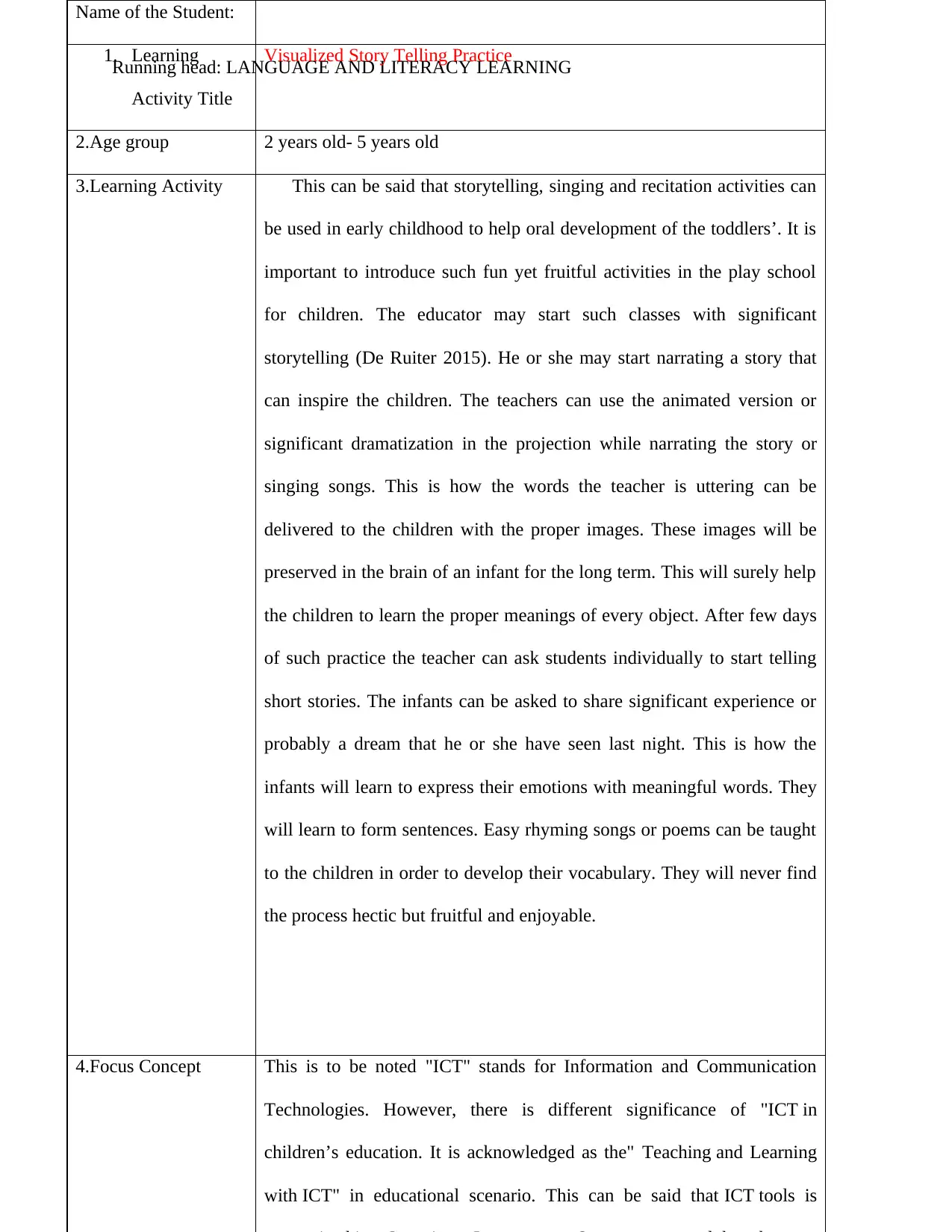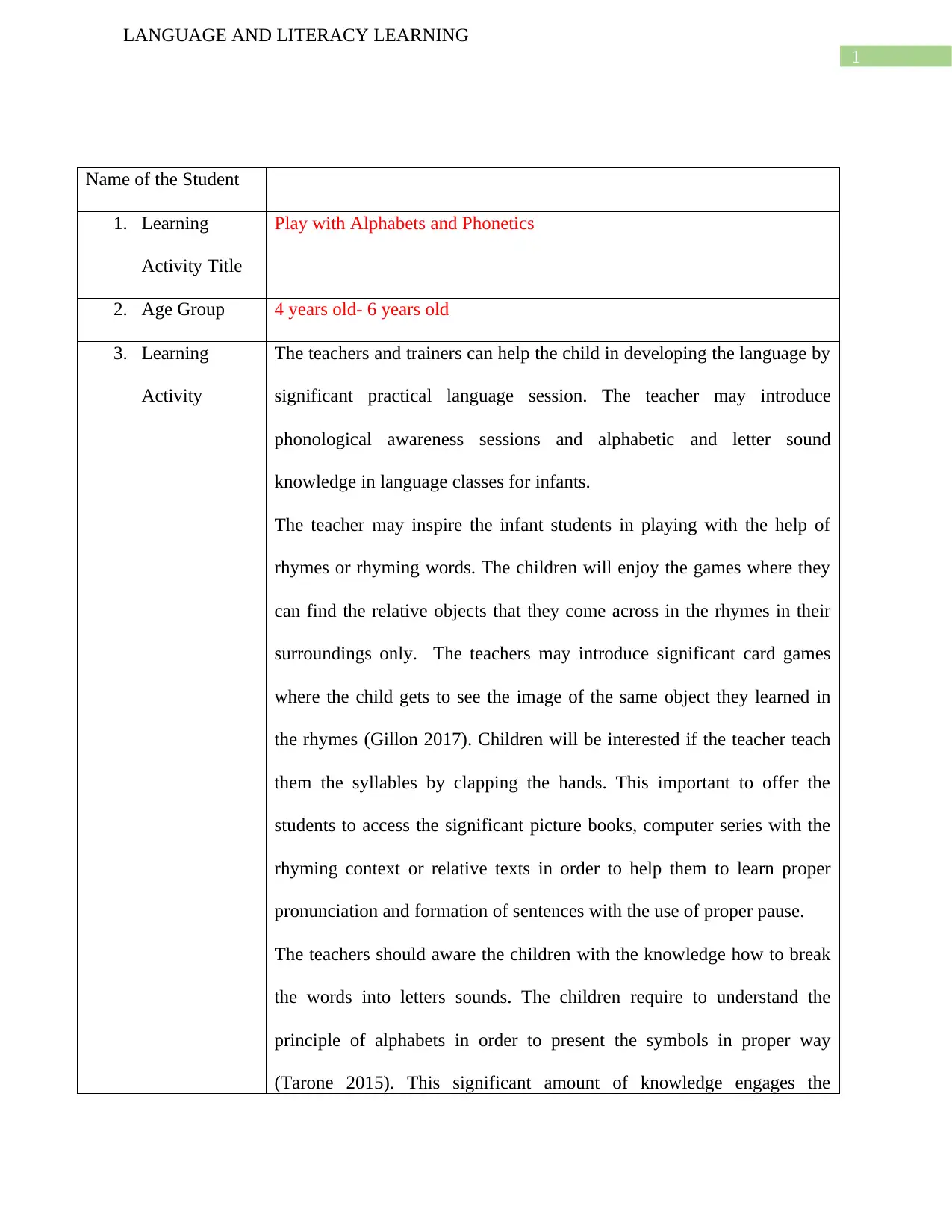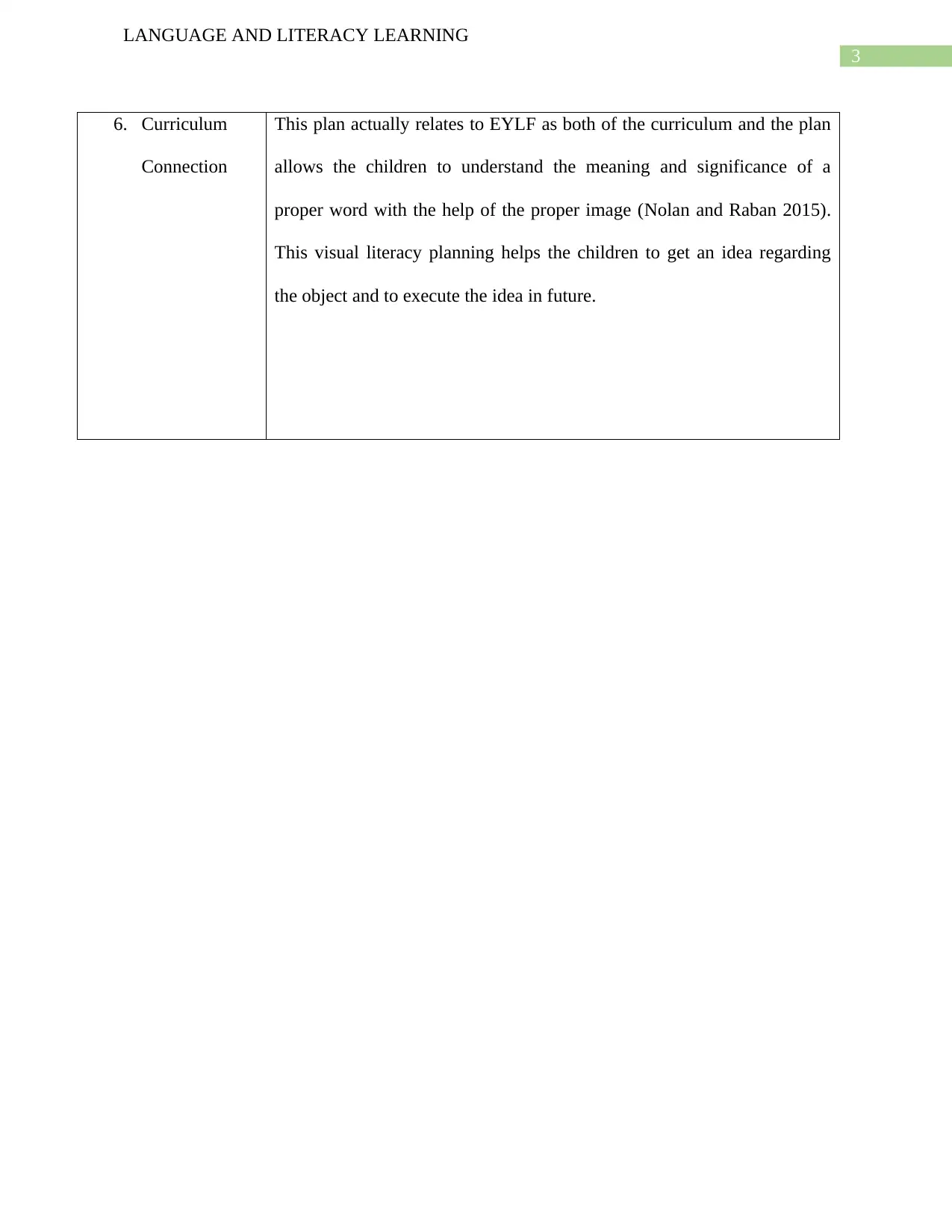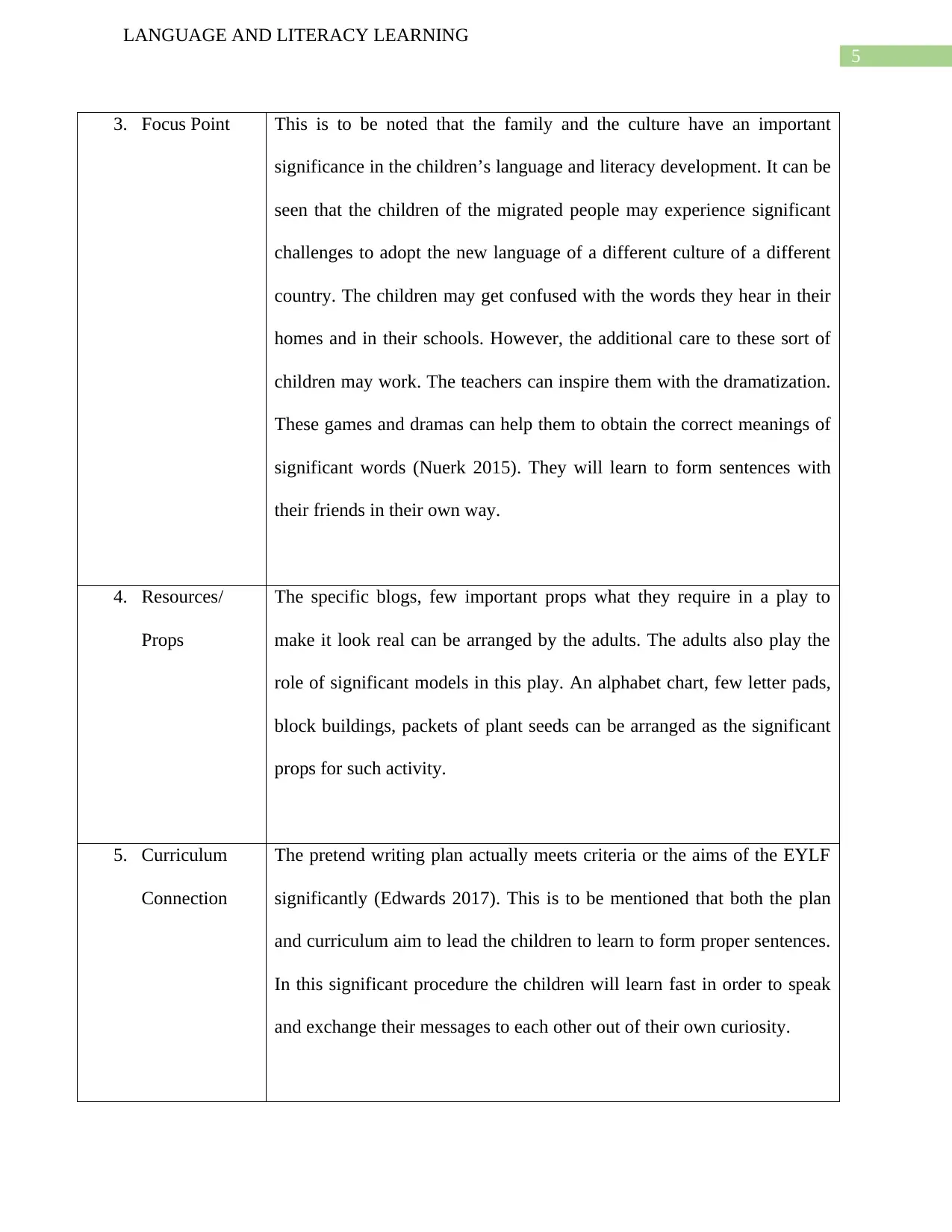Language and Literacy Learning: Storytelling, Games for Development
VerifiedAdded on 2021/04/21
|6
|1941
|112
Practical Assignment
AI Summary
This assignment focuses on language and literacy learning activities suitable for young children, ranging from 1 to 6 years old. It explores the use of visual storytelling, alphabet and phonetics games, and pretend learning to enhance oral language development, phonological awareness, and literacy skills. The activities incorporate ICT tools, gamification, and visual aids to engage children and promote vocabulary development, sentence formation, and comprehension. The assignment also emphasizes the importance of family and cultural context in language acquisition and aligns with the Early Years Learning Framework (EYLF) by encouraging children to express themselves and understand the meaning of words through images and practical experiences. This resource is available on Desklib, where students can find more past papers and solved assignments.

Running head: LANGUAGE AND LITERACY LEARNING
Name of the Student:
1. Learning
Activity Title
Visualized Story Telling Practice
2.Age group 2 years old- 5 years old
3.Learning Activity This can be said that storytelling, singing and recitation activities can
be used in early childhood to help oral development of the toddlers’. It is
important to introduce such fun yet fruitful activities in the play school
for children. The educator may start such classes with significant
storytelling (De Ruiter 2015). He or she may start narrating a story that
can inspire the children. The teachers can use the animated version or
significant dramatization in the projection while narrating the story or
singing songs. This is how the words the teacher is uttering can be
delivered to the children with the proper images. These images will be
preserved in the brain of an infant for the long term. This will surely help
the children to learn the proper meanings of every object. After few days
of such practice the teacher can ask students individually to start telling
short stories. The infants can be asked to share significant experience or
probably a dream that he or she have seen last night. This is how the
infants will learn to express their emotions with meaningful words. They
will learn to form sentences. Easy rhyming songs or poems can be taught
to the children in order to develop their vocabulary. They will never find
the process hectic but fruitful and enjoyable.
4.Focus Concept This is to be noted "ICT" stands for Information and Communication
Technologies. However, there is different significance of "ICT in
children’s education. It is acknowledged as the" Teaching and Learning
with ICT" in educational scenario. This can be said that ICT tools is
Name of the Student:
1. Learning
Activity Title
Visualized Story Telling Practice
2.Age group 2 years old- 5 years old
3.Learning Activity This can be said that storytelling, singing and recitation activities can
be used in early childhood to help oral development of the toddlers’. It is
important to introduce such fun yet fruitful activities in the play school
for children. The educator may start such classes with significant
storytelling (De Ruiter 2015). He or she may start narrating a story that
can inspire the children. The teachers can use the animated version or
significant dramatization in the projection while narrating the story or
singing songs. This is how the words the teacher is uttering can be
delivered to the children with the proper images. These images will be
preserved in the brain of an infant for the long term. This will surely help
the children to learn the proper meanings of every object. After few days
of such practice the teacher can ask students individually to start telling
short stories. The infants can be asked to share significant experience or
probably a dream that he or she have seen last night. This is how the
infants will learn to express their emotions with meaningful words. They
will learn to form sentences. Easy rhyming songs or poems can be taught
to the children in order to develop their vocabulary. They will never find
the process hectic but fruitful and enjoyable.
4.Focus Concept This is to be noted "ICT" stands for Information and Communication
Technologies. However, there is different significance of "ICT in
children’s education. It is acknowledged as the" Teaching and Learning
with ICT" in educational scenario. This can be said that ICT tools is
Paraphrase This Document
Need a fresh take? Get an instant paraphrase of this document with our AI Paraphraser

1
LANGUAGE AND LITERACY LEARNING
Name of the Student
1. Learning
Activity Title
Play with Alphabets and Phonetics
2. Age Group 4 years old- 6 years old
3. Learning
Activity
The teachers and trainers can help the child in developing the language by
significant practical language session. The teacher may introduce
phonological awareness sessions and alphabetic and letter sound
knowledge in language classes for infants.
The teacher may inspire the infant students in playing with the help of
rhymes or rhyming words. The children will enjoy the games where they
can find the relative objects that they come across in the rhymes in their
surroundings only. The teachers may introduce significant card games
where the child gets to see the image of the same object they learned in
the rhymes (Gillon 2017). Children will be interested if the teacher teach
them the syllables by clapping the hands. This important to offer the
students to access the significant picture books, computer series with the
rhyming context or relative texts in order to help them to learn proper
pronunciation and formation of sentences with the use of proper pause.
The teachers should aware the children with the knowledge how to break
the words into letters sounds. The children require to understand the
principle of alphabets in order to present the symbols in proper way
(Tarone 2015). This significant amount of knowledge engages the
LANGUAGE AND LITERACY LEARNING
Name of the Student
1. Learning
Activity Title
Play with Alphabets and Phonetics
2. Age Group 4 years old- 6 years old
3. Learning
Activity
The teachers and trainers can help the child in developing the language by
significant practical language session. The teacher may introduce
phonological awareness sessions and alphabetic and letter sound
knowledge in language classes for infants.
The teacher may inspire the infant students in playing with the help of
rhymes or rhyming words. The children will enjoy the games where they
can find the relative objects that they come across in the rhymes in their
surroundings only. The teachers may introduce significant card games
where the child gets to see the image of the same object they learned in
the rhymes (Gillon 2017). Children will be interested if the teacher teach
them the syllables by clapping the hands. This important to offer the
students to access the significant picture books, computer series with the
rhyming context or relative texts in order to help them to learn proper
pronunciation and formation of sentences with the use of proper pause.
The teachers should aware the children with the knowledge how to break
the words into letters sounds. The children require to understand the
principle of alphabets in order to present the symbols in proper way
(Tarone 2015). This significant amount of knowledge engages the

2
LANGUAGE AND LITERACY LEARNING
consideration as a methodical relation between the letters of the
significant alphabet and the sounds of them.
4. Focus Concept This is to be mentioned that the visual literacy can be identifies and
acknowledged as the important tool in children’s language and literacy
development in Australia. Visual literacy can be acknowledged as the
capability to comprehend, understand and analyze the significant visual
communications (Barton 2017). Therefore, it can be said that Visual
literacy is constructed on the basic concept of the images need to be read
and understand that specific meaning by communicating through a
procedure of reading and knowing.
The teacher may print significant and important photo associated with
the learning texts and distribute different photos to different group. Then,
the students may asked to analyze the photos and write significant
descriptions for the photographs (Flood, Heath and Lapp 2015). This will
surely help the students to think and form sentences.
5. Resources/
Props
Multiple number of new media tools can be used as resources for this
activity. It will help both the teacher and students to include write ups in
the body of an image or a photo. The teacher may use the Flickr Notes or
Bubble Snaps to add comments or significant answers related to the
learning problem to guide the people through the world (Larsen-Freeman
and Long 2014). .
LANGUAGE AND LITERACY LEARNING
consideration as a methodical relation between the letters of the
significant alphabet and the sounds of them.
4. Focus Concept This is to be mentioned that the visual literacy can be identifies and
acknowledged as the important tool in children’s language and literacy
development in Australia. Visual literacy can be acknowledged as the
capability to comprehend, understand and analyze the significant visual
communications (Barton 2017). Therefore, it can be said that Visual
literacy is constructed on the basic concept of the images need to be read
and understand that specific meaning by communicating through a
procedure of reading and knowing.
The teacher may print significant and important photo associated with
the learning texts and distribute different photos to different group. Then,
the students may asked to analyze the photos and write significant
descriptions for the photographs (Flood, Heath and Lapp 2015). This will
surely help the students to think and form sentences.
5. Resources/
Props
Multiple number of new media tools can be used as resources for this
activity. It will help both the teacher and students to include write ups in
the body of an image or a photo. The teacher may use the Flickr Notes or
Bubble Snaps to add comments or significant answers related to the
learning problem to guide the people through the world (Larsen-Freeman
and Long 2014). .
⊘ This is a preview!⊘
Do you want full access?
Subscribe today to unlock all pages.

Trusted by 1+ million students worldwide

3
LANGUAGE AND LITERACY LEARNING
6. Curriculum
Connection
This plan actually relates to EYLF as both of the curriculum and the plan
allows the children to understand the meaning and significance of a
proper word with the help of the proper image (Nolan and Raban 2015).
This visual literacy planning helps the children to get an idea regarding
the object and to execute the idea in future.
LANGUAGE AND LITERACY LEARNING
6. Curriculum
Connection
This plan actually relates to EYLF as both of the curriculum and the plan
allows the children to understand the meaning and significance of a
proper word with the help of the proper image (Nolan and Raban 2015).
This visual literacy planning helps the children to get an idea regarding
the object and to execute the idea in future.
Paraphrase This Document
Need a fresh take? Get an instant paraphrase of this document with our AI Paraphraser

4
LANGUAGE AND LITERACY LEARNING
Name of the Student
1. Learning
Activity Title
Pretend Learning Games
1. Age Group 1 years old- 6 years old
2. Learning
Activity
This is to be noted that language of literacy activity should filled with fun
programs to encourage the children. There is a process named pretend
learning can proved to beneficial for infant learning (Bailey et al. 2016). It
can be seen that the infants in their play school years can write only their
names properly. However, they pretend to write significant write ups
using specific symbols or sign. This is the exact time to encourage them.
The teachers may ask them to invite their friends with invitation letters in
their birthday. The students may ask for writing a personal message to his
or best friend. This is how the child actually starts taking interest in
writing. The teachers may ask them to do a significant drama by
providing significant situations. It is evident that the children plays a
significant pretentious games where they play the role of a doctor,
conductor or a travel agent or significantly beyond the predictions of
adults. The students may encouraged to do significant dramatization of a
familiar story or a fairy tell. This is how they actually learn to form
sentences in order to comminute or play the particular character. They
may speak significant gibberish sentences. However they should be
encouraged in continuing this procedure.
LANGUAGE AND LITERACY LEARNING
Name of the Student
1. Learning
Activity Title
Pretend Learning Games
1. Age Group 1 years old- 6 years old
2. Learning
Activity
This is to be noted that language of literacy activity should filled with fun
programs to encourage the children. There is a process named pretend
learning can proved to beneficial for infant learning (Bailey et al. 2016). It
can be seen that the infants in their play school years can write only their
names properly. However, they pretend to write significant write ups
using specific symbols or sign. This is the exact time to encourage them.
The teachers may ask them to invite their friends with invitation letters in
their birthday. The students may ask for writing a personal message to his
or best friend. This is how the child actually starts taking interest in
writing. The teachers may ask them to do a significant drama by
providing significant situations. It is evident that the children plays a
significant pretentious games where they play the role of a doctor,
conductor or a travel agent or significantly beyond the predictions of
adults. The students may encouraged to do significant dramatization of a
familiar story or a fairy tell. This is how they actually learn to form
sentences in order to comminute or play the particular character. They
may speak significant gibberish sentences. However they should be
encouraged in continuing this procedure.

5
LANGUAGE AND LITERACY LEARNING
3. Focus Point This is to be noted that the family and the culture have an important
significance in the children’s language and literacy development. It can be
seen that the children of the migrated people may experience significant
challenges to adopt the new language of a different culture of a different
country. The children may get confused with the words they hear in their
homes and in their schools. However, the additional care to these sort of
children may work. The teachers can inspire them with the dramatization.
These games and dramas can help them to obtain the correct meanings of
significant words (Nuerk 2015). They will learn to form sentences with
their friends in their own way.
4. Resources/
Props
The specific blogs, few important props what they require in a play to
make it look real can be arranged by the adults. The adults also play the
role of significant models in this play. An alphabet chart, few letter pads,
block buildings, packets of plant seeds can be arranged as the significant
props for such activity.
5. Curriculum
Connection
The pretend writing plan actually meets criteria or the aims of the EYLF
significantly (Edwards 2017). This is to be mentioned that both the plan
and curriculum aim to lead the children to learn to form proper sentences.
In this significant procedure the children will learn fast in order to speak
and exchange their messages to each other out of their own curiosity.
LANGUAGE AND LITERACY LEARNING
3. Focus Point This is to be noted that the family and the culture have an important
significance in the children’s language and literacy development. It can be
seen that the children of the migrated people may experience significant
challenges to adopt the new language of a different culture of a different
country. The children may get confused with the words they hear in their
homes and in their schools. However, the additional care to these sort of
children may work. The teachers can inspire them with the dramatization.
These games and dramas can help them to obtain the correct meanings of
significant words (Nuerk 2015). They will learn to form sentences with
their friends in their own way.
4. Resources/
Props
The specific blogs, few important props what they require in a play to
make it look real can be arranged by the adults. The adults also play the
role of significant models in this play. An alphabet chart, few letter pads,
block buildings, packets of plant seeds can be arranged as the significant
props for such activity.
5. Curriculum
Connection
The pretend writing plan actually meets criteria or the aims of the EYLF
significantly (Edwards 2017). This is to be mentioned that both the plan
and curriculum aim to lead the children to learn to form proper sentences.
In this significant procedure the children will learn fast in order to speak
and exchange their messages to each other out of their own curiosity.
⊘ This is a preview!⊘
Do you want full access?
Subscribe today to unlock all pages.

Trusted by 1+ million students worldwide
1 out of 6
Related Documents
Your All-in-One AI-Powered Toolkit for Academic Success.
+13062052269
info@desklib.com
Available 24*7 on WhatsApp / Email
![[object Object]](/_next/static/media/star-bottom.7253800d.svg)
Unlock your academic potential
Copyright © 2020–2025 A2Z Services. All Rights Reserved. Developed and managed by ZUCOL.





